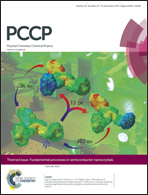Graphene–CdS quantum dots–polyoxometalate composite films for efficient photoelectrochemical water splitting and pollutant degradation†
Abstract
rGO–CdS–H2W12 nanocomposite film was successfully fabricated by a layer-by-layer self-assembly method. The composite film was characterized by techniques such as UV-Vis spectra, XPS, and AFM. The composite film showed high photoelectronic response under the illumination of sunlight. Both current–voltage curves and photocurrent transient measurements demonstrated that the photocurrent response of the rGO–CdS–H2W12 composite film was enhanced five-fold compared with CdS film. This can be attributed to the photoinduced electron transfer between CdS, H2W12 and rGO, which promotes the charge separation efficiency of CdS. The introduction of GO enhanced the charge separation and transportation. More importantly, various pollutants can be treated as electron donors, and can thus be degraded and produce hydrogen at the same time, at a low bias voltage under the irradiation of solar light.


 Please wait while we load your content...
Please wait while we load your content...